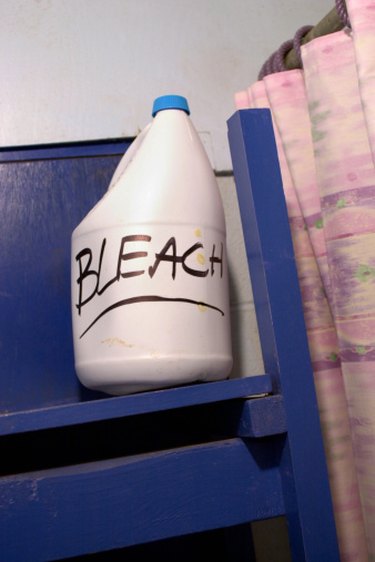
The presence of black mold inside the home can damage the structure of the home and the health of those who live in it. Mold begins to grow quickly in damp, humid conditions, usually within 24 to 48 hours. The Centers for Disease Control, or CDC, recommends removing all mold growth regardless of its color or toxicity. Clorox bleach is effective in removing all types of mold, although you should use it with caution.
Identification
Video of the Day
Fungi causes mold growth, which lands on areas of moisture inside the home. Some of the most common types of household mold are Alternaria, Aspergillus, Penicullium and Cladosporium. The fungus Stachybotrys chartarum causes black mold, which is less common than other types of household mold, but it does occur. According to the CDC, black mold grows rapidly on materials with low nitrogen content and a high level of cellulose, such as fiberboard, dust, lint and paper. You should consider all mold as dangerous and remove it promptly to avoid adverse health effects.
Video of the Day
Diagnosis
If you can see black mold growing inside your home, you have a mold problem that requires swift removal. Black mold also has a musty or earthy odor, which is also indicative of mold growth. Some mold can hide underneath wallpaper or vinyl flooring, making it difficult to find. Clorox bleach will kill mold on hard surfaces, such as floors, counters, sinks and stoves. However, bleach does not kill mold spores that become airborne during the cleaning process.
Removal
The CDC recommends that homeowners use bleach to kill mold on hard surfaces. When using bleach to remove mold, you must protect yourself from dangerous fumes. Avoid mixing bleach with any other cleaning products, especially ammonia, which can cause a build-up of noxious fumes. Always open a window in the room you are working in to provide adequate ventilation. Wear goggles, long sleeves, long pants, rubber boots, rubber gloves and a N-95 mask. You should typically combine no more than 1 cup of bleach with 1 gallon of water and scrub the item with a stiff brush. After scrubbing the black mold away, rinse with clear water and dry.
Considerations
While bleach kills mold on surfaces, airborne mold spores can be dangerous for people who have serious respiratory illnesses, such as asthma, or those who are allergic to mold. Those who suffer from these conditions should not attempt to remove mold with bleach or remain inside the home during its removal. Exposure to airborne mold spores can cause difficulty breathing, sudden onset of asthmatic symptoms and symptoms similar to hay fever like sneezing and itchy eyes. The CDC recommends that all homeowners who have areas of mold growth that exceed 10 square feet to contact a mold removal specialist. Once you kill mold growth with bleach and remove it, you must find also address the source of the moisture causing the growth. Failure to reduce indoor humidity and moisture will result in the regrowth of mold.
- Centers for Disease Control and Prevention: Protect Yourself From Mold
- Centers for Disease Control and Prevention: Mold General Information: Basic Facts
- Centers for Disease Control and Prevention: Mold General Information: Facts About Stachybotrys Chartarum
- Centers for Disease Control and Prevention: Flyer Get Rid Of Mold